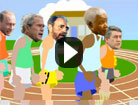I have been tardy in keeping up with Stephanie West Allen and Jeffrey Schwartz’s new initiative, Brains on Purpose.
When I did start reading it this morning, I got immersed in reading back through Stephanie’s material. One of the many things that struck me was the post on naming feelings, following on from a flurry of articles on the subject in Scientific American, The Daily Telegraph and other titles.
One of the most powerful lines in the first Batman film was when Jack Nicholson’s Joker says: “I have a name for my pain.” I was never quite sure why it was so resonant.
This whole emerging area of neuroplasticity , which West Allen and Schwartz explore in Brains On Purpose, with particular regard to conflict resolution, shows the power of naming feelings in helping to damp down unhelpful emotional patterns – patterns that lead to conflict or distraction from purpose – and amplify constructive emotional patterns; kind of a ‘brain, heal thyself’ approach.
I was attracted to this work through Schwartz and David Rock’s work on what they call the Neuroscience of Leadership – based on the new theory that the brain changes shape according to our experiences and thoughts and feelings.
The neurons themselves don’t change, according to the theory. But, the web of synapses between them thickens and grows where our focus of attention is greatest. Which is why, for example, when famously opinionated London Black Cab drivers like to think they have bigger brains than anyone else, it turns out they are right. The hippocampus in their brain is larger than in the average person, because before they earn their cab driver’s licence they have to learn The Knowledge – hold a mental map in their heads of every street in London and the shortest routes from place to place.
I’ve based the Leadership Hub on the principle of the power of attention in building up synapses, borrowing Rock and Schwartz’s principle that we learn best in small doses – maybe fifteen minutes a week.
Nature versus Nurture is beginning to look very much like last century’s argument. As so often, the answer looks increasingly like ‘and’ rather than ‘either/or’.
More, below, on self-organizing systems that shape themselves and grow as they are used.









Leave a Reply